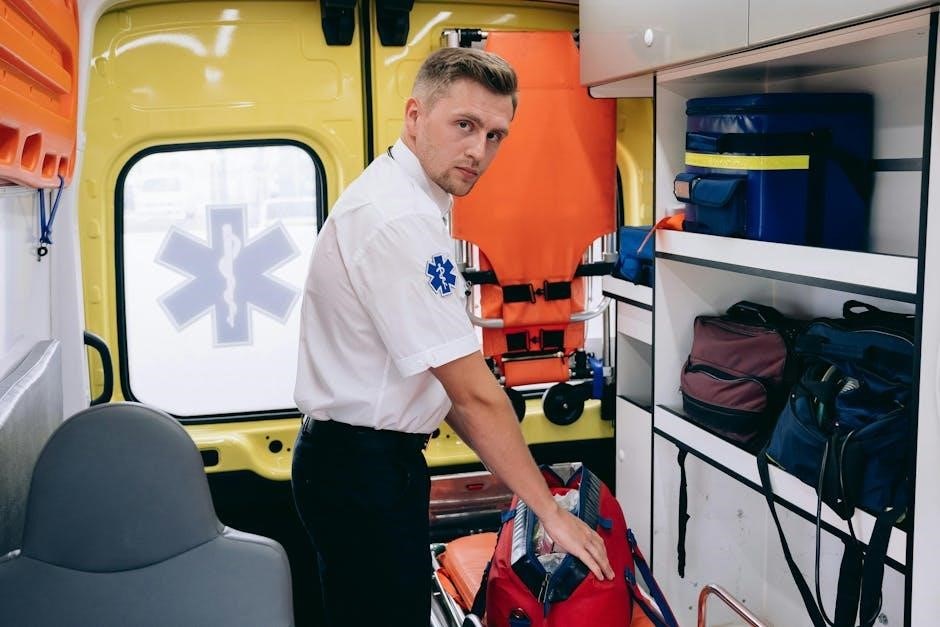EMT trauma scenarios pdf provides essential training for emergency medical technicians, including
- step-by-step guides
and realistic
- simulation exercises
to prepare for critical situations, using
various formats
like pdf files.
Overview of Trauma Scenarios
EMT trauma scenarios pdf offers a comprehensive overview of various trauma scenarios, including chest injuries and blunt chest trauma, to help emergency medical technicians prepare for real-life situations. The pdf files provide detailed information on patient assessment and management, as well as medical procedures to follow in different trauma scenarios. Using
- ordered lists
and
- unordered lists
, the pdf files outline the steps to take in each scenario, from initial assessment to transportation to a medical facility. The
formats
of the pdf files are designed to be easy to read and understand, with clear headings and concise language. By studying the EMT trauma scenarios pdf, emergency medical technicians can gain the knowledge and skills needed to respond effectively in emergency situations, and provide the best possible care for patients. The pdf files are a valuable resource for EMT training programs, and can be used in conjunction with other training materials to provide a comprehensive education.

Types of Trauma Scenarios
EMT trauma scenarios include
- multiple
types, such as chest and blunt trauma, requiring
- specific
training and equipment, using various
formats
for effective response always.
Chest Injuries and Blunt Chest Trauma
Chest injuries and blunt chest trauma are critical conditions that require immediate attention from emergency medical technicians. According to various sources, including EMT trauma scenarios pdf, these types of injuries can be life-threatening if not treated promptly and properly. The symptoms of chest injuries and blunt chest trauma can vary, but common signs include chest pain, shortness of breath, and difficulty breathing. EMTs must be trained to recognize these symptoms and provide appropriate care, including administering oxygen and performing chest compressions if necessary. The use of EMT trauma scenarios pdf can help technicians prepare for these types of situations and provide the best possible care for patients. By studying these scenarios, EMTs can gain valuable experience and develop the skills needed to respond to chest injuries and blunt chest trauma effectively. This training is essential for saving lives and improving patient outcomes.

Medical Assessment and Management
EMTs use
- medical tools
and
- assessment techniques
to manage patient care effectively always.
Patient Assessment and Management
EMTs must be able to assess patients quickly and accurately in emergency situations, using various techniques and tools to determine the best course of treatment. This includes evaluating the patient’s airway, breathing, and circulation, as well as assessing for any injuries or illnesses that may be present. EMTs must also be able to manage the patient’s care effectively, including administering medications, providing oxygen, and performing other interventions as needed. According to the emt trauma scenarios pdf, patient assessment and management is a critical component of emergency medical care, and EMTs must be well-trained and equipped to handle a wide range of situations. By using emt trauma scenarios pdf, EMTs can practice and improve their patient assessment and management skills, leading to better outcomes for patients. The emt trauma scenarios pdf provides a valuable resource for EMTs to learn and improve their skills in patient assessment and management.

Qualifying for EMS National Certification
EMTs must pass cognitive and psychomotor exams using
- study guides
and
- practice tests
to qualify for EMS national certification.
Passing the Cognitive and Psychomotor Exams
To become a certified EMT, one must pass both the cognitive and psychomotor exams, which assess their knowledge and skills in patient assessment and management, as well as trauma scenarios. The cognitive exam is a multiple-choice test that evaluates the EMT’s understanding of emergency medical concepts and procedures. The psychomotor exam, on the other hand, is a practical test that assesses the EMT’s ability to perform specific skills, such as patient assessment and trauma management. EMTs can prepare for these exams by using study guides and practice tests, which are available online in various formats, including pdf files. By passing these exams, EMTs can demonstrate their competence and qualify for EMS national certification, which is essential for their career advancement. The exams are administered by the National Registry of Emergency Medical Technicians (NREMT) and are designed to ensure that EMTs have the necessary knowledge and skills to provide high-quality patient care.

Thoracic Injuries and Trauma Mortality
Thoracic injuries are a leading cause of trauma mortality, accounting for a significant number of deaths each year. According to recent statistics, thoracic injuries are the second leading cause of trauma-related deaths, resulting in approximately 12,000 fatalities annually in the United States. The majority of these deaths are due to heart and great vessel trauma, which can lead to exsanguinating hemorrhage and respiratory failure. EMTs play a crucial role in managing thoracic injuries and preventing further complications. By understanding the causes and consequences of thoracic injuries, EMTs can provide effective care and improve patient outcomes. The importance of prompt and proper treatment of thoracic injuries is emphasized in various EMT training materials, including online resources and pdf files. These resources provide EMTs with the knowledge and skills necessary to respond to thoracic injuries and reduce the risk of trauma mortality. Effective management of thoracic injuries requires a comprehensive approach.
BLS Trauma Scenarios
BLS trauma scenarios are an essential component of emergency medical training, providing EMTs with the skills and knowledge necessary to respond to critical situations. These scenarios are designed to simulate real-world trauma cases, allowing EMTs to practice and refine their techniques in a controlled environment. Various online resources, including pdf files, offer a range of BLS trauma scenarios for EMTs to study and learn from. These scenarios typically involve a combination of medical and traumatic injuries, requiring EMTs to assess and manage patients effectively. By working through these scenarios, EMTs can develop their critical thinking and decision-making skills, as well as their ability to work effectively in high-pressure situations. The use of BLS trauma scenarios in EMT training helps to ensure that emergency medical responders are well-prepared to handle a wide range of trauma cases, from minor injuries to life-threatening conditions, and provide the best possible care for patients. EMTs can access these scenarios through online platforms and training materials, including EMT trauma scenarios pdf files.